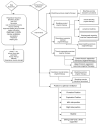Effectiveness of Nonpharmacological Interventions in the Field of Ventilation: An Umbrella Review
- PMID: 37047855
- PMCID: PMC10093871
- DOI: 10.3390/ijerph20075239
Effectiveness of Nonpharmacological Interventions in the Field of Ventilation: An Umbrella Review
Abstract
This umbrella review aimed to determine the effectiveness of nonpharmacological interventions in pulmonary ventilation and their impact on respiratory function. An individual with impaired ventilation displays visible variations manifested in their respiratory frequency, breathing rhythm ratio (I:E), thoracic symmetry, use of accessory muscles, dyspnea (feeling short of breath), oxygen saturation, diaphragm mobility, minute ventilation, peak flow, walking test, spirometry, Pimax/Pemax, diffusion, and respiratory muscle strength. Any variation in these markers demands the need for interventions in order to duly manage the signs and symptoms and to improve ventilation.
Method: Systematic reviews of the literature published in English, Spanish, French, and Portuguese were used, which included studies in which nonpharmacological interventions were used as a response to impaired ventilation in adults in any given context of the clinical practice. The recommendations given by the Joanna Briggs Institute (JBI) for umbrella reviews were followed. This research took place in several databases such as MEDLINE, CINAHL Complete, CINHAL, MedicLatina, ERIC, Cochrane Reviews (Embase), and PubMed. The Joanna Briggs critical analysis verification list was used for the systematic review. The data extraction was performed independently by two investigators based on the data extraction tools of the Joanna Briggs Institute, and the data were presented in a summary table alongside the support text.
Results: Forty-four systematic reviews, thirty randomized clinical essays, and fourteen observational studies were included in this review. The number of participants varied between n = 103 and n = 13,370. Fifteen systematic revisions evaluated the effect of isolated respiratory muscular training; six systematic revisions evaluated, in isolation, breathing control (relaxed breathing, pursed-lip breathing, and diaphragmatic breathing exercises) and thoracic expansion exercises; and one systematic review evaluated, in isolation, the positions that optimize ventilation. Nineteen systematic reviews with combined interventions that reinforced the role of education and capacitation while also aiming for their success were considered. The articles analyzed isolated interventions and presented their efficacy. The interventions based on respiratory exercises and respiratory muscular training were the most common, and one article mentioned the efficacy of positioning in the compromisation of ventilation. Combined interventions in which the educational component was included were found to be effective in improving pulmonary function, diffusion, oxygenation, and functional capacity. The outcomes used in each study were variable, leading to a more difficult analysis of the data.
Conclusions: The interventions that were the focus of the review were duly mapped. The results suggest that nonpharmacological interventions used to optimize ventilation are effective, with a moderate to high level of evidence. There is a strong foundation for the use of the chosen interventions. The lack of studies on the intervention of "positioning to optimize ventilation" points out the need for a deeper analysis of its effects and for studies with a clear focus. This study supports the decisions and recommendations for the prescription of these interventions to patients with impaired ventilation.
Keywords: health impact assessment; nonpharmacological interventions; nursing; rehabilitation; review.
Conflict of interest statement
The authors declare no conflict of interest.
Figures
Similar articles
-
Strategy nursing in children with compromised ventilation: Umbrella review.J Pediatr Nurs. 2023 Nov-Dec;73:137-156. doi: 10.1016/j.pedn.2023.08.027. Epub 2023 Sep 8. J Pediatr Nurs. 2023. PMID: 37690429
-
Umbrella review of nonpharmacological interventions for intrinsic capacity in older adults.Ageing Res Rev. 2025 Jun;108:102742. doi: 10.1016/j.arr.2025.102742. Epub 2025 Apr 5. Ageing Res Rev. 2025. PMID: 40194665
-
[Standard technical specifications for methacholine chloride (Methacholine) bronchial challenge test (2023)].Zhonghua Jie He He Hu Xi Za Zhi. 2024 Feb 12;47(2):101-119. doi: 10.3760/cma.j.cn112147-20231019-00247. Zhonghua Jie He He Hu Xi Za Zhi. 2024. PMID: 38309959 Chinese.
-
The future of Cochrane Neonatal.Early Hum Dev. 2020 Nov;150:105191. doi: 10.1016/j.earlhumdev.2020.105191. Epub 2020 Sep 12. Early Hum Dev. 2020. PMID: 33036834
-
The Effectiveness of Integrated Care Pathways for Adults and Children in Health Care Settings: A Systematic Review.JBI Libr Syst Rev. 2009;7(3):80-129. doi: 10.11124/01938924-200907030-00001. JBI Libr Syst Rev. 2009. PMID: 27820426
References
-
- Dean E., Frownfelter D.L. Cardiovascular and Pulmonary Physical Therapy: Evidence and Practice. 5th ed. Mosby; St. Louis, MO, USA: 2005.
-
- International Council of Nurses ICNP Browser. 2019. [(accessed on 20 March 2022)]. Available online: https://www.icn.ch/what-we-do/projects/ehealth-icnptm/icnp-browser.
-
- Frownfelter D.L., Dean E., Stout M., Kruger R., Anthony J. Cardiovascular and Pulmonary Physical Therapy: Evidence and Practice. St. Mosby Elsevier; New York, NY, USA: 2021.
-
- ICN . Classificação Internacional Para a Prática de Enfermagem Versão 2. Ordem dos Enfermeiros; Lisboa, Portugal: 2011.
Publication types
MeSH terms
LinkOut - more resources
Full Text Sources



